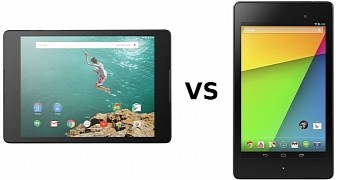Just a few hours ago, Google finally launched its highly anticipated Nexus 9 tablet, which weirdly enough didn't happen during a big fancy event.
Google unleashed its new slate via a simple blog post, alongside the Nexus 6 smartphone and Android 5.0 Lollipop.
The Nexus 9 is a much needed refresh of Google’s tablet portfolio, which didn't see any novelties since 2013 when the second-gen Nexus 7 made an appearance.
So at this point you might be wondering what sets the new Nexus 9 apart from the older Nexus 7, except for the obvious form factor difference. Continue reading to find out.
Display and Design
Of course, the thing you are most likely to notice is that the Nexus 9 takes advantage of a more spacious 8.9-inch IPS LCD display, while the Nexus 7 comes with a 7-inch IPS screen.
The larger tablet boasts 2048 x 1536 pixel resolution (with 288 ppi) while the Nexus 7 has 1920 x 1200 pixels (with 323 ppi).
The Nexus 7 might be primary made of plastic, but it doesn't feel too cheap because of the finish used. On the other hand, we expected the Nexus 9 to don the same material and the tablet has a plastic back, but comes with a metal frame.
Power and Performance
The Nexus 7 (2013) takes advantage of a 1.5GHz Qualcomm Snapdragon S4 Pro processor fitted with 2GB of RAM and backed up by either 16GB or 32GB of internal storage.
On the other hand, the Nexus 9 is the first Nexus device to rely on a 64-bit processor – the 2.3GHz NVIDIA Tegra K1. The Tegra K1 platform hasn't showed in a lot of tablets (except Xiaomi MiPad and NVIDIA’s own Shiled Tablet), but judging by its benchmarks, it should provide advanced levels of performance.
The new tablet also has 2GB of RAM and can be fitted either with 16GB or 32GB of internal storage. Both models are offered in LTE variants.
Cameras
Google has upgraded things in the photo department as well, so if the Nexus 7 had a 5MP camera adorning the back and a 1.2MP up in front, the Nexus 9 takes advantage of an 8MP main snapper and 1.6MP secondary camera.
Connectivity and Ports
The Nexus 7 takes advantage of 802 a/b/g/n Dual-band Wi-Fi, Bluetooth 4.0, 3.5mm headphone jack, HDMI out and micro USB for memory extension. The tablet is sustained by a 3950mAh battery.
On the other hand, the Nexus 9 boasts 802.11 a/b/g/n/ac (2.3 & 5GHz), Bluetooth 4.0, 3.5mm headphone jack and a mini USB. The power source of the tablet is a 6700 mAh battery which will reportedly be able to allow a life cycle of up to 9 hours.
OS
Both these tablets are Android models, but back when it was launched, the Nexus 7 ran Android 4.3 out of the box. But since Nexus 7 devices are the first to receive Google’s new updates, the tab can be bumped up to Android 4.4.4. Is Lollipop next?
As for the Nexus 9, this is the first tablet to step out into the world with Android 5.0 Lollipop onboard, so those of you purchasing the device won’t have to worry about updates for some time.
Pricing
So far, the Nexus tablet line has been characterized by bringing about worthy specs at affordable price tags. The Nexus 7 (2013) with 16GB of internal storage was originally sold for $230 / €179, but users could soon find the tab under discounted prices.
By comparison, the Nexus 9 is the priciest tablet to date. The device will be offered in three configurations, including with 16GB for $399 / €312, with 32GB for $479 / €375 and 32GB with LTE for $599 / €468.

 14 DAY TRIAL //
14 DAY TRIAL //